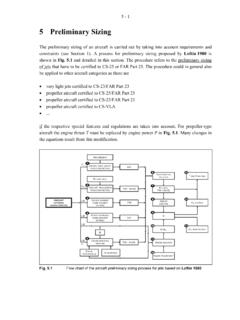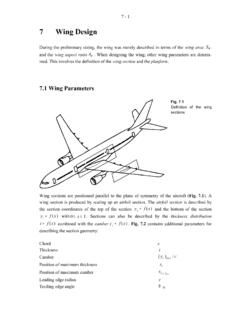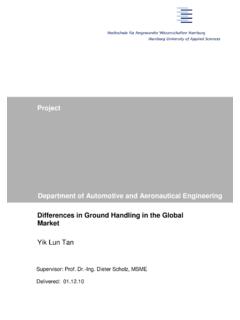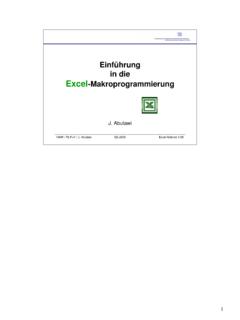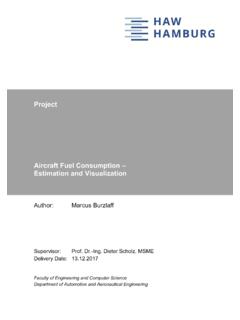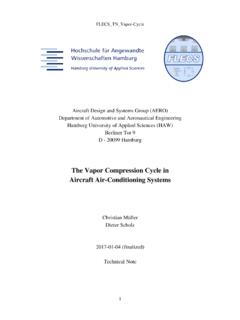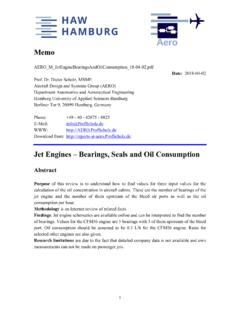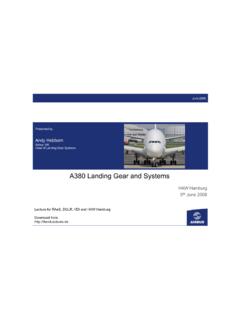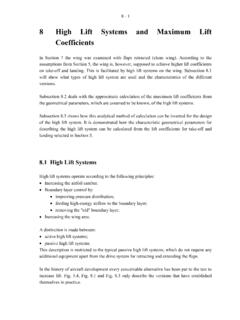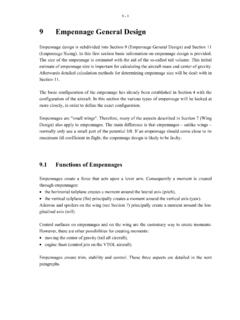Transcription of 4 Aircraft Configurations - HAW Hamburg
1 4 - 1 4 aircraft configurations Aircraft can be categorized by several aspects. One way is to divide into: homebuilt single engine propeller driven airplane twin engine propeller driven airplane agricultural airplane business jet regional turboprop jet transport supersonic civil transport, SCT seaplane In addition there are several categories of military Aircraft . Three-View Drawings of Conventional Aircraft Configurations Three-view drawings are the most important medium to communicate within Aircraft design. In the following, some examples of three-view drawings of conventional Aircraft Configurations are shown as an animation for own design ideas.
2 Fig Single engine piston prop. Cessna 182S Skylane: Pax: 4, vCR: 140 kt, R: 820 NM, MTOW: t. (Roskam II) 4 - 2 Fig Single engine piston prop. Aerospatiale, Socata TB 10 Tobago: Pax: 4, vCR: 127 kt, R: 688 NM, MTOW: t. (Roskam II) Fig Twin engine piston prop. Piper Seminole - PA - 44 - 180: Pax: 4, vCR: 162 kt, R: 770 NM, MTOW: t. (Roskam II) Fig Twin engine regional. Pilatus BN-2A: piston engine. Pilatus BN-2T: turboprop engine. Pax: 9, vCR: 170 kt, R: 140 NM, MTOW: t. (Roskam II) 4 - 3 Fig Business jet. Learjet 45: Pax: 9, vCR: 464 kt, R: 1849 NM, MTOW: t. (Lambert 1993) Fig Turboprop regional.
3 Fokker 50: Pax: 50, vCR: 278 kt, R: 1610 NM, MTOW: t. (Green 1988) 4 - 4 Fig Turboprop regional. Shorts 330: Pax: 30, vCR: 190 kt, R: 473 NM, MTOW: t. (Green 1988) Fig Jet transport. BAe 146, later: Avro RJ85: Pax: 96, vCR: 423 kt, R: 1176 NM, MTOW: t. (Green 1988) Fig 4 - 5 Jet transport. Boeing 737-300: Pax: 128, vCR: 490 kt, R: 1387 NM, MTOW: t. (Green 1988) Fig Airbus A380-800, Jet transport. Pax: 555, MTOW: 560 t. (Trahmer 2000) 4 - 6 Fig Supersonic civil transport. Concorde: Pax: 100, vCR: 1160 kt, MCR: 2 R: 3209 NM, MTOW: 185 t. (Roskam II) Each configuration has its advantages and disadvantages.
4 In general, advantages in one place mean disadvantages elsewhere. Therefore, advantages and disadvantages have to be assessed during trade-off studies. For someone who was not involved in an Aircraft s design process it is not easy to find out for which reason a particular design feature was chosen. When discussing advantages and disadvantages of several Configurations one should always keep in mind that each person has its own subjective preferences. These personal views must not preclude to perfom an assessment as objective as possible. Three-View Drawings of Unconventional Configurations Though conventional Configurations differ in many aspects they all have a fuselage, wings and an empennage at their rear end.
5 This configuration is called tail aft Aircraft . Unconventional Aircraft Configurations differ in at least one attribute from these main attributes of a conventional configuration . Examples of unconventional Configurations are: The canard (Fig ) has its horizontal tail at its front instead of its rear end. The three-surface Aircraft (Fig ) has in addition to its conventional empennage at its rear end an additional horizontal tail at its front end. The flying wing (Fig ) has no fuselage. It only consists of a wing which also carries the payload. Unlike the conventional pivoting wing Aircraft , the pivoting oblique wing Aircraft (Fig ) has only one swivel joint.
6 The oblique flying wing Aircraft , OFW (Fig ) combines the ideas of a flying wing a swept wing . 4 - 7 The joined wing Aircraft (Fig ) can be advantageous due lower mass at same stiffness. The double fuselage Aircraft (Fig ) can be advantageous due to the economically more efficient fabrication of twice the number of fuselages. Fig Canard: Beech Starship (Roskam II) Fig Three-surface Aircraft : Gates Piaggio GP-180 (Roskam II) 4 - 8 Fig Flying wing : Northrop XB-35 (Roskam II) Fig Pivoting oblique wing Aircraft : NASA AD-1 Experimental Aircraft . Sweep adjustable from 0 to 60.
7 (Barnard 1991) Fig Oblique flying wing Aircraft , OFW Study: DaimlerChrysler Aerospace Airbus. Pax: 250, MCR: , Sweep: 45 .. 68 (Li 1996) 4 - 9 The following figure holds a list of keywords for the description of several aspects of an Aircraft configuration . Overall configuration Land based Aircraft Sea plane Amphibian plane Conventional, also called: tail aft Canard Three-surface Aircraft Flying wing Pivoting oblique wing Aircraft Fuselage configuration Conventional Fuselage double fuselage Aircraft double boom central fuselage Engine type Piston prop Turbo prop Turbo jet Turbo fan Propfan.
8 Unducted Fan Engine integration Engine in nacelles on the wing or on the fuselage Engine inside the wing or inside the fuselage wing Cantilever Braced High wing position Low wing position Mid wing position Straight wing Aft swept wing Forward swept wing Pivoting oblique swept wing wing with or without winglets 4 - 10 Horizontal tail on the fuselage on two tail booms T-tail V-tail, butterfly tail Vertical tail on the fuselage on two tail booms on each tip of the horizontal tail Landing gear Fixed or retractable gear Tail-wheel or nose-wheel landing gear Landing gear integration in the wing in the engine nacelles in the fuselage in fairings Fig Aircraft configuration aspects Fig Joined wing Aircraft .
9 Study (Roskam II) 4 - 11 Fig double fuselage Aircraft . Exemplary design for Aircraft design lecture Fachhochschule Hamburg (Marckwardt 1997)
